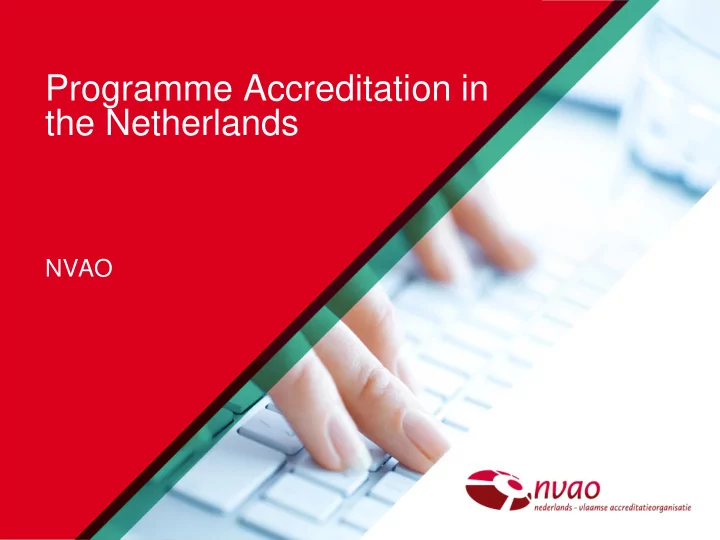

Programme Accreditation in the Netherlands NVAO
Topics I. Introduction NVAO II. Some key figures III. Higher education in the Netherlands IV. Accreditation system V. Quality Assurance System VI. Accreditation framework VII.So far ... VIII.Next accreditation system
I. INTRODUCTION NVAO • The accreditation organisation of the Netherlands and Flanders (Belgium) • Set up by international treaty (°2003) • Independent (towards government and HEI‟s) in • procedures, • methodologies, • decision making • Funded by the Netherlands and Flanders government (60/40)
II. Key figures Inhabitants >16 million Universities 22 Hogescholen 113 Students >550 000 Bachelor Degr. 2050 Master Degr. 950
III. HIGHER EDUCATION 1. Degree structure • professional bachelor and master degrees (universities of professional education) • academic bachelor and master degrees (universities and universities of professional education) 2. Degree structure in line with Bologna Process • Dublin descriptors • Overarching Qualifications Framework in EHEA (adopted in Bergen, 2005)
IV. ACCREDITATION (I) Programme accreditation is the core • Dutch quality assurance system before Bologna: • focus on programmes • external assessment of programme • Bologna process: • international transparency • benchmarking bachelor & master degrees • Same requirements for public & private providers • Embedding QA culture in the programmes before shifting to accreditation on a higher level
IV. ACCREDITATION (II) Elements of programme accreditation • accreditation decision = yes / no • no ranking • validity 6 years • accreditation necessary to obtain: • public funding • recognition of degrees • student support (eg. grants)
IV. ACCREDITATION (III) Initial accreditation (of „new‟ programmes) • Assessment of the potential quality of a new programme • (Assessment of macro-efficiency by ministry for publicly funded new programmes) • Initial accreditation necessary for: • public funding • recognition of degrees • student support
IV. ACCREDITATION (IV) Quality assurance agencies • NVAO does not itself take responsibility for preparing assessment reports • NVAO decisions: based on assessment reports by QA agencies • NVAO protocol for QA agencies • NL: list of QA agencies (“VBIs”)
V. QUALITY ASSURANCE SYSTEM INTERNAL EVALUATION Not public Institution SELF EVALUATION PROGRAMME REPORT Quality improvement EXTERNAL ASSESMENT cycle QA Agency ASSESSMENT ASSESSMENT REPORT PANEL Public ACCREDITATION Public NVAO ACCREDITATION ACCREDITATION NVAO REPORT DECISION
VI. ACCREDITATION FRAMEWORK 1. Assessment framework: 6 themes standards criteria Themes: • • aims and objectives of the programme • curriculum • staff • facilities internal quality assurance system • • results
VI. ACCREDITATION FRAMEWORK Example : theme “internal QA system” Standard 1: Internal quality assurance system the programme and the curriculum is evaluated periodically, in the light of empirical targets Standard 2: Improvement measures the outcomes of the evaluation form the basis for measures for improvement that contribute to realising the targets Standard 3: Involvement of personnel, students, alumni, professional field actively involved in internal quality assurance
VI. ACCREDITATION FRAMEWORK 2. Assessment rules Assessment of standards Assessment of themes Excellent Good Positive / Negative Sufficient Insufficient compensation possible a „negative‟ theme results in a negative accreditation decision
VI. ACCREDITATION FRAMEWORK 2. Assessment rules • Example : Theme “internal QA system” Assessment of standards Assessment of themes Example 1 Standard 1: Good Positive Standard 2: Sufficient Standard 3: Excellent Example 2 Standard 1: Sufficient Positive/Negative Standard 2: Sufficient Standard 3: Insufficient
VI. ACCREDITATION FRAMEWORK How does NVAO decide on accreditation? scope 1: the assessment panel quality and composition of the assessment panel • • QA protocol of assessment agency • assessment framework used • assessment rules used
VI. ACCREDITATION FRAMEWORK How does NVAO decide on accreditation? scope 2: the assessment report assessment of every standard and every theme • • assessment based on (objective) facts and (subjective) evaluations • comparisons with similar degree courses • international standards • final conclusion
VII. SO FAR … Today NVAO has assessed a total of 3135 programmes: 2 from the Netherlands Antilles, 2677 from the Netherlands and 456 from Flanders.
VII. SO FAR … Strengths • An enormous drive for quality, especially within universities of professional education • Focus on education • Staff involvement at program level • Bad quality providers are being detected • Increased international credibility of Dutch HEIs • Huge political support for the system • Information tool for students and stakeholders, comparison of programmes possible
VII. SO FAR … Weaknesses • “Safety first” behaviour • Production of a lot of paperwork by HEIs System stimulates bureaucratic behaviour • • “Improvement function” is less visible • Roles and positions of NVAO and QA agencies • Dilemma QAAs: listening to HEI vs. “obeying” NVAO • Operationalisation of accreditation frameworks by QAAs • The system is very expensive • The system needs frequent updates
VIII. Next accreditation system After the first cycle (10 years): development towards institutional audit institutional no institutional audit audit positive negative restricted elaborate programme programme assessment assessment
Thank you Further requests and information: • e-mail victor@victorrutgers.com website NVAO www.nvao.net •
Recommend
More recommend